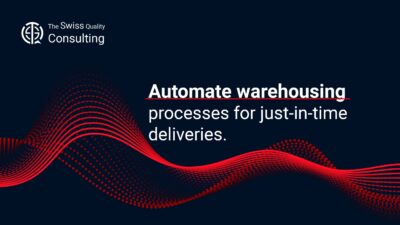Revolutionizing Warehouse Management for Efficiency and Timeliness
Automating Warehousing Processes for Just-In-Time Deliveries is becoming increasingly important for businesses focused on optimizing their supply chain efficiency. This approach, critical for business executives, mid-level managers, and entrepreneurs, plays a key role in ensuring timely delivery of products, reducing inventory costs, and improving overall customer satisfaction.
Importance of Automation in Warehousing for Just-In-Time Deliveries
Just-in-time (JIT) delivery systems transcend mere inventory reduction; they serve as a strategic catalyst for optimizing logistics and enhancing operational efficiency. The success of JIT hinges heavily on the transformation of warehousing processes through automation. This transformative approach leverages cutting-edge technologies to:
1. Accelerate Goods Handling and Processing: Automated sorting systems, robotics for material handling, and integrated software solutions streamline the flow of goods throughout the warehouse. This significantly reduces handling times, increases throughput, and minimizes delays.
2. Enhance Accuracy and Reduce Error Rates: Automation eliminates manual tasks, minimizing the risk of human error in picking, packing, and sorting. This ensures greater accuracy in order fulfillment, leading to reduced costs, improved customer satisfaction, and increased brand trust.
3. Optimize Inventory Management and Visibility: Real-time inventory management software provides complete visibility and control over stock levels. This allows for dynamic inventory planning and forecasting, ensuring sufficient stock to meet demand without incurring unnecessary carrying costs.
4. Foster Data-Driven Decision-Making: Automated systems generate valuable data on warehouse operations, providing deeper insights into performance metrics. This data empowers informed decision-making, allowing for continuous improvement and optimization of warehousing processes.
5. Improve Flexibility and Scalability: Automation enables seamless scaling of operations to meet fluctuating demand. This ensures the warehouse can adapt to changing business needs, accommodate seasonal peaks, and handle unexpected surges in order volume.
6. Enhance Employee Productivity and Safety: By automating repetitive and physically demanding tasks, automation empowers employees to focus on higher-value activities. This improves employee satisfaction and safety, while also reducing workplace accidents and injuries.
7. Foster a Culture of Continuous Innovation: Automation creates an environment where innovation and technology adoption are encouraged. This fosters a culture of continuous improvement within the warehouse, driving the development and implementation of new technologies and best practices.
Beyond Inventory Reduction: A Foundation for Sustainable Supply Chain Excellence:
By prioritizing the automation of JIT warehousing, organizations unlock the true potential of optimized logistics and a resilient supply chain. This strategic approach empowers them to accelerate goods handling, enhance accuracy, optimize inventory management, make data-driven decisions, improve flexibility and scalability, enhance employee productivity and safety, and foster a culture of continuous innovation. Ultimately, this leads to greater operational efficiency, reduced costs, improved customer satisfaction, and a sustainable competitive advantage in the global marketplace.
Embrace the power of automated JIT warehousing and embark on a transformative journey towards a future where your supply chain is not just efficient, but agile, adaptable, and ready to thrive in any competitive landscape. By investing in the right technologies, fostering a culture of innovation, and empowering your workforce to leverage technology effectively, you can unlock the full potential of your logistics operations and build a future of sustainable supply chain excellence.
Incorporating Generative Artificial Intelligence in Warehouse Automation
Generative AI can play a transformative role in warehouse automation. It can optimize logistics and inventory management by predicting demand patterns, thereby aligning warehouse operations with real-time market needs. AI can also assist in layout optimization, path planning for automated vehicles, and predictive maintenance of equipment.
Executive Coaching for Effective Implementation of Warehouse Automation
Successfully integrating automation into warehousing requires strategic leadership and management skills. Executive coaching services can equip leaders with the necessary insights and strategies for effective implementation. This includes navigating technological changes, managing teams during the transition, and aligning the new systems with broader business goals.
Effective Communication in Automated Warehousing Systems
Effective communication is vital in the transition to automated warehousing, especially for JIT deliveries. It involves ensuring that all stakeholders, from warehouse staff to suppliers and customers, understand the new processes and their roles within them. Clear communication helps in managing expectations and smoothing the transition to automated operations.
Project Management in Automating Warehouse Processes
Introducing automation into warehousing is a complex project that needs to be meticulously managed. Effective project management ensures that the implementation is on schedule, within budget, and meets the set objectives. It involves coordinating different teams, managing resources, and overseeing the installation and integration of new technologies.
Change Management for Seamless Transition to Automation
Adopting new technologies in warehousing often requires significant changes in workflow and employee roles. Effective change management strategies are crucial for a seamless transition. This includes training employees, addressing concerns, and creating a culture that embraces technological advancements and continuous improvement.
Conclusion Automating Warehousing Processes for Just-In-Time Deliveries
Automating warehousing processes for just-in-time deliveries is more than just a technological upgrade; it’s a strategic business move. By embracing warehouse automation, businesses can achieve greater efficiency, reduce operational costs, and enhance their responsiveness to market demands, ultimately contributing to greater business success.
#WarehouseAutomation, #JustInTime, #SupplyChainEfficiency, #AIInLogistics, #BusinessStrategy, #TechnologyInnovation























